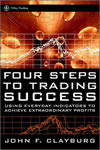|
|
|
Spectrum Trading System The Spectrum System enters positions using the classic concepts of follow through and range expansion. A self adaptive pattern recognition routine defines the probability of an intraday trend continuing into the next several trading sessions. Breakouts of the early range in the direction of the anticipated follow-through trend are used to enter market positions. Testing Results Dow e mini Futures Contract Individual Contract Testing
** Through August 15, 2003 System
Theory The
SPECTRUM portfolio trading method utilizes two basic theories of short term
trend analysis - follow through and range expansion. Follow
Through Follow
through can best be described as a tendency of a market, when in a short-term
trend, to stay in the trend into the next day of For
our purposes, we'll define the strength or weakness of a daily trend by the
relative position of the close with respect to the high and the low of the day. If
the close is relatively near the high of the day the market is exhibiting a
strong close - one which should follow through to the upside in early trading
for the next day. If
the close is nearer the lowest price of that market for the day, it is defined
to be a weak close which should lead to lower prices during at least the early
part of the trade tomorrow.
Is
every follow through signal effective? Of course not, but the percentage is
great enough, when combined with range expansion, to give us a definite edge in
the market. Range
Expansion
Range
expansion is another rather basic concept, which by itself, has some trading
merit. Its effectiveness is expanded considerably Think
about the first few minutes of trading posted for the day.
What is the likelihood of this range being the range for the entire day?
I think you would agree that it is reasonably small. Since we are fairly certain
that the range will expand from this point, it would be SPECTRUM Approach
The
spectrum approach to trading combines both the follow through and range
expansion tendencies into one trading theory. Although the concept is simple and
straightforward, the calculations are not. The
SPECTRUM System program calculates the relative strength or weakness of the
market over the past several days using the follow through strategy outlined
above. This calculation gives the system a long or short bias for the next
trading day. It
then calculates the probability of the market, with respect to expected follow
through, to move higher or lower from the open based on historical behavior of
the market in question. The SPECTRUM Daily System
is a true reversal system, or one which is always in the market. A buy signal
reverses the position from short to long; a sell signal reverses the position
from long to short. If
the system is in a short position a buy stop is placed above the daily open
which will reverse the position from short to long if the If
the system is in a long position a sell stop is placed below the daily open
which will reverse the position from long to short if our stop is hit. No other stops are active
in the system as it has been programmed and tested other than the end of day
exit for the intra-day system. Users should feel free to add additional money management, target, or trailing stops to the by adding the signals provided within the TradeStation Platform.
|
 By John F. Clayburg
JOHN WILEY & SONS, INC. |